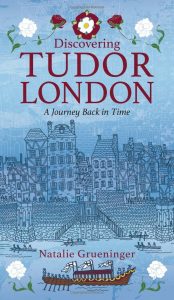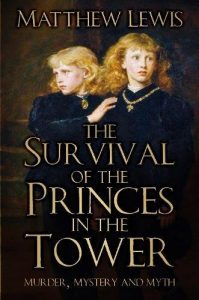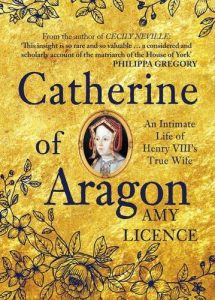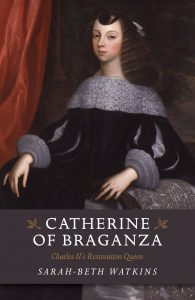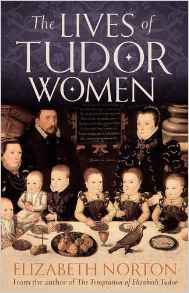‘Discovering Tudor London: A Journey Back in Time’ is the perfect companion for those wanting to explore the London that the Tudors would have known.
The guide includes houses, halls, palaces, castles, churches, religious houses, museums and art galleries. The scene is set by the Tudor Timeline, the illustrative map groups places together and the itineraries help you plan your visit whether you are in London for a long weekend, a week or longer.
There are fascinating tips throughout which tell you what to look out for at each place and what was particularly interesting were the details of where places used to be (see ‘Visitor Information’ sections), for example the sites of Norfolk House, a former home of Katherine Parr and Chelsea Place.
Places linked to Lady Jane Grey include the Tower of London and the Guildhall. The places of burial of Jane’s mother (Frances Grey) and mother-in-law (Jane Dudley) are also listed (Westminster Abbey and Chelsea Old Church).
The book is the perfect size to fit in your bag. On my next trips to Hampton Court and the Tower of London, I will take this book with me, to make sure I don’t miss out.
Thank you to History Press for my review copy.
The Survival of the Princes in the Tower by Matthew Lewis
‘The Survival of the Princes in the Tower’ is a thoroughly researched and well-argued investigation of one of the great unsolved historical mysteries. In this detailed look at the fate of the sons of Edward IV, Lewis explores the events of the summer of 1483, the disappearance of the princes, who might have been responsible and asks if they actually died that summer?
The majority of the book looks at the threats faced by Henry VII from ‘pretenders’ to the crown throughout his reign and asks the question if any of them really were the lost princes? The fact that Henry VII seemed unsure of the answer is intriguing.
One chapter look at various theories that the princes survived into the reign of Henry VIII, their possible identities and one has a possible link to the attempted usurpation of the throne in July 1553.
This is a must read for anyone interested in the Princes in the Tower.
Catherine of Aragon: An Intimate Life of Henry VIII’s True Wife by Amy Licence
Licence’s biography of Catherine of Aragon is an incredibly well written and fascinating look at the Spanish Princess who became Queen of England. By exploring Katherine’s childhood in Spain, where she was brought up to be Princess of Wales from the age of 3, Licence clearly shows how the role model of her mother, Queen Isabella, and events of the reign of ‘The Catholic Monarchs’ shaped the Queen that Katherine was to become.
Although Katherine is chiefly remembered today as the first of six wives to Henry VIII, she was much more than that. From her grand entry into London to become the bride of Prince Arthur, their magnificent wedding at St Paul’s, their short lived marriage and the years of uncertainty Katherine faced afterwards, Licence presents a very human Katherine.
As Queen of England, Katherine followed in her mother’s footsteps, serving as regent, while Henry VIII was in France and overseeing the English triumph over the Scots at the Battle of Flodden. She also took an active political role and her opinions were trusted and respected by Henry.
Katherine’s first marriage to Henry’s brother Arthur, is one of the great ‘what-ifs?’ of English history. Not only what would have happened if Arthur had lived but also the question of what happened on their wedding night. Licence looks at the question that would come back to haunt Katherine in detail and offers an interesting alternative theory.
Until recent years Katherine has been largely overlooked but in this biography the piety, courage and determination of the woman and Queen that Katherine was is clear to see.
Thank you to Amberley Publishing for my review copy of this book
Catherine of Braganza: Charles II’s Restoration Queen by Sarah-Beth Watkins
This short biography of Catherine of Braganza is an interesting, straight forward and fast paced overview of the life of one of England’s less well known queens.
Watkins clearly shows the difficulties faced by a Catholic Queen in a Protestant country and how the childless Catherine dealt with the many mistresses and illegitimate children of Charles II at the restoration court.
Catherine’s struggle to find her place as Queen is set against the dramatic back drop of plots against her, the war against the Dutch, the plague and the great fire of London. It is a great starting point for those wanting to learn more about queenship in this period.
The Lives of Tudor Women by Elizabeth Norton
‘The Lives of Tudor Women’ by Elizabeth Norton begins with the birth of the first Princess Elizabeth Tudor (the short-lived second daughter of Henry VII and Elizabeth of York) and ends with the death of her niece, Queen Elizabeth, over a century later. These ‘lives are the full-stops between which countless lives of other Tudor women were lived’ (p.1) and it is these women who are at the centre of this incredibly well written and fascinating book.
Following the ‘Seven Ages of Man’, Norton investigates each stage of Tudor Woman’s life. To illustrate this fully, Elizabeth uses examples of well-known women (Elizabeth of York, Anne Boleyn, Mary Tudor), known but not as well documented women (Elizabeth Howard – mother of Anne Boleyn, Anne Askew, Elizabeth Barton) and many women who’s stories have been forgotten. These women include, Joan Bocher (the only woman burned during the reign of Edward VI), the widow Katherine Fenkyll, who took over her husband’s business and trained apprentices, Margaret Cheyne, who died for the role she played in the Pilgrimage of Grace and Alice Cotton, who aged 80, still spun wool to support herself in her old age.
The depth of Norton’s research is clear, with numerous examples of women’s lives. The background information sections throughout the book, range from ‘Riot Girls of Tudor England’ to ‘The practisers of physick’, and anecdotes, such as Elizabeth I’s calling out to the bishop during a sermon that he ‘should keep his arithmetic for himself’ when he dared to mention her age. (p.302)
Thanks to this book, the women who lined the routes of Coronation processions and royal progresses throughout the Tudor age will no longer be anonymous faces in the crowd.

